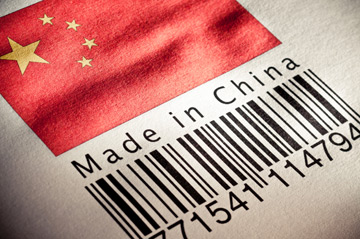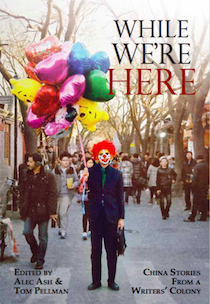Made in China
Laszlo Montgomery’s other life in Chinese manufacturing

In my China History Podcast series I have touched on China trade going all the way back to the times of the Han Dynasty adventurer Zhang Qian. Trade with China has always been exotic and unique. Silk, tea, lacquerware and other valuables ware sold along the fabled trade routes to all points between Rome and Asia. Zhang Qian, Marco Polo, the Silk Road, the Tea Horse Road, Zheng He, Macao, the Canton System, the Noble House. For an old China hand, what isn’t there to love about this world of China trade?
But when I first started out as a China watcher, back in the day, I didn’t realise that in my professional life I would become part of it myself.
***
I graduated from college with a History and Asian Studies degree, and sought out a China life that would allow me to use my language skills on the job. I was in my early twenties, and my sights couldn’t have been more vague. Eventually, I scored gainful employment in Hong Kong, starting in September 1989. I would stay in that crazy industry for the next twenty-five years.
Over the course of my career I worked for three Chinese manufacturers of consumer goods. All three operations made stuff that lined the shelves of the big US retailers from coast to coast, and all three were real factories, not trading companies or middlemen. When buyers of “Made in China” merchandise did their product sourcing, they were looking for companies like mine. Behind us were hundreds of raw material suppliers and sub-contractors, but as far as our clients were concerned, the Chinese factory was the source. The buck stopped with us.
To find myself neck deep in this business in 1989 was a dream come true. A typical China trip was straight from the airport to the factories. I felt like Salieri when he finally got to Vienna in the 18th century. I had gone from reading about this life to actually being a part of it. Based in Hong Kong, every morning brought a new experience in Shenzhen or wherever else I had to go that day.
I worked for three different enterprises over a quarter century, two in Hong Kong and one in Ningbo, but my job was essentially the same. As the sole Westerner in the company, with the best understanding of foreign ways and the most polished English, I applied those advantages to help each company reel in more business. Many more niche problems also became part of my job description. Over the years that covered a lot of strange and miscellaneous things, and a week rarely passed when I didn’t have to placate an angry Western customer or save the day by more underhand means.
For the sake of growing business, the company usually left the coddling of customers to me. Cozying up to China officials in karaoke bars was also a regular thing, always cooing to them to obtain maximum support for whatever it was we needed. Aside from this innocent mischief there were often favors and tasks I had to take care of that weren’t altogether legal and better left unsaid.
The export manufacturing industry was the locomotive that pulled China’s economy out of the mud. It’s said that five hundred million Chinese have been lifted out of poverty since the beginning of reform and opening up in 1978. Thank the factories and exporters like those I worked for. The changes China have gone through in the last thirty years are the ripple effect of millions upon millions of workers for these export manufacturers bringing their hard earned yuan inland and spreading the wealth around.
From my perch in 2014, I now look back on the early nineties and think, like an old codger who can’t keep up with the times, that those were the good old days. No one can deny that China is still a land of great opportunity for fortune seekers – but in the business of getting sweatpants, writing pads, toys, daily use articles, housewares, hardware and all other manner of general merchandise to market, for a Chinese factory it just isn’t what it used to be.
When the American consumer walks into Wal-Mart, Staples, Hobby Lobby, Big Lots or TJ Maxx, the volume of choices boggles the mind. Who hasn’t walked into a Costco in the US for the first time, looked around and thought, what a land of plenty is this? But for me, every display of merchandise reminds me of a story or, more often, an incident. From the famous brands to the cheapo brands, my guys made them all.
It’s great from a consumer standpoint, but it sucks for the Chinese factory. The supply chain from China to US distribution centres has now been tightened down to levels undreamed of thirty years ago. Each of the three companies I worked for employed between 2,500 and 5,000 people. That’s a lot of paychecks, and in the past few years the industry has become impersonal and mean.
Since Zhang Qian’s days, the human relationship that solidified the buyer-seller relationship was one of an exporter’s most prized and secret assets. With a dependable factory in place, anything was possible. If you were a mensch about doing business and the Chinese liked you, those manufacturers could be lifesavers and pull your company back from the brink of disaster.
In the nineties, finding suppliers for buyers wasn’t as easy as it is today. I started out, before the Internet, sourcing was still done the hard way. Unless you had an agent or an office in Hong Kong, you had to get on a plane, fly fourteen hours and go to a trade show in Hong Kong or Canton. The process was time consuming and laborious. But back then everyone marveled, with our mobile phones as big as a loaf of bread, at how lucky we were to be living with all this new technology.
Then came the Internet. Now both buyer and seller could find each other more easily. In no time at all, the people I worked for became commoditised. The Internet had simplified the months long process of finding suppliers from two buying trips a year, in April and October, to a ten minutes search on Alibaba, Baidu or Google. Suddenly the outstanding merits of factories like mine became secondary to price. No matter how well a factory paid its workers, how consistent the quality, how clean they were or how well they complied to safety regulations, if they didn’t have a brand, all this took a back seat to offering the cheapest price.
Now, it was so easy to slam that China price down to the bone marrow. All you had to do was find six to eight factories, ask them to quote your sample, and go with the lowest cost producer. If the factory you preferred wasn’t the cheapest, you took the lowest price and waved it at your top choice, offering them a last chance. If the first choice factory didn’t take the order, number two or three did. The prevailing thought in China with many factories was that this money-losing order would open the door to future profitable opportunities. The Great Lie.
A few years ago, I took a step back and realised that the manufacturers making America’s products faced an impossible future. The RMB was rising. There was a labour shortage. No matter how good the factories were, they were replaceable. Fungible. Once lionised, with vendor summits where awards were meted out to various categories of best factory, now they had become bile bears for big US retailers.
The Chinese manufacturing world I had enjoyed for so long began to decay and take on a bad smell. As pressures mounted to slash costs and satisfy retailers’ profit margins, quality was sacrificed and corners were cut. “Made in China” more than ever became synonymous with poorly made goods.
But don’t blame the Chinese for that. All the shoddy, shitty, poorly made schlock that you put in your shopping basket at your local dollar store was approved and signed off on by a buyer back home. If they said this piece of shit was good enough for the American consumer, the Chinese factory was happy to comply. Imagine how I felt sitting on the Chinese side of the table when some American retailer, for the sake of hitting a price point, gave the factory the thumbs up on that flimsier, cheaper material.
***
I followed my heart in 1989 and took the China path in life. I wasn’t skilled at anything in particular, but I had learnt Chinese and let the waves carry me into the world of Made in China. It was a lucrative way to make a living. It took me to new places. And it allowed me to develop beautiful lasting friendships with Westerners and Chinese both. Now I’ve amicably parted ways with the Ningbo based manufacturer that was my last employer. For the time being, hanging in Southern California and working on the China History Podcast will take up most of my days.
China History Podcast listeners might remember the episodes I did on the life of Morris “Two Gun” Cohen, a Westerner who played a two-bit role in early Republican China as the bodyguard of Sun Yat-sen. Small and insignificant as he may have been, he still got to be there up close and watch it happen. I identify with Morris in that I got to be part of the Chinese manufacturing glory days of the eighties and nineties.
In the last few years, I would go to trade shows and see row after row of booths for these once proud factories. They were kings once, all of them, punching out goods selling for less than $4.99 at retail, disparaged but bought all the same by the American consumer. Now so many of them were fighting for their lives, and I wondered if they would be at that same booth next year or not.
Every China hand aspires to be a bridge between their country and the Middle Kingdom. In my twilight years I can look back fondly on my time as an American in the heyday of Made in China – building bridges, defending the ordinary worker, and doing my bit for China’s economic miracle.
•
LA-based Laszlo Montgomery is the elusive genius behind China History Podcast. Watch out for a new ten-part series on the podcast, beginning in December
For more on this topic, check out Paul Midler’s 2012 book Poorly Made in China: An Insider’s Account of the China Production Game


















